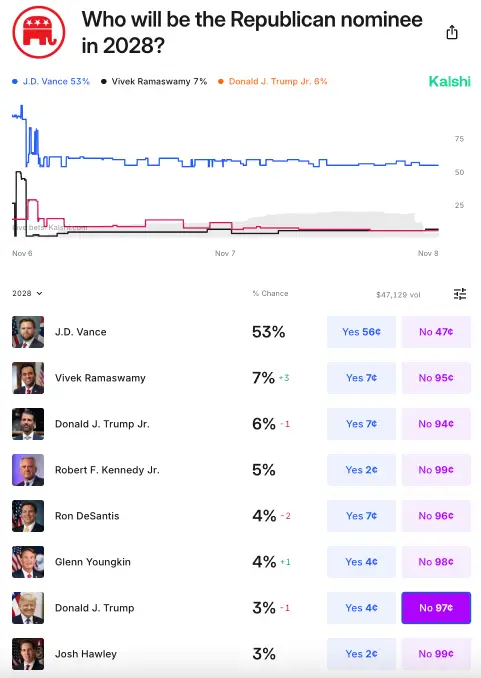Kalshi has already launched its 2028 presidential markets, and major Republican figures already have money on them. J.D. Vance has a 55% chance of being the 2028 nominee while Donald Trump Jr. has a 6% chance.

However, Donald Trump has a 3% chance of becoming the 2028 nominee. American presidents can only serve two terms because of the 22nd Amendment. Under the Constitution, Trump shouldn’t have a chance at a second term at all.
There are two major reasons that Trump is available in this market. One is customer demand. Ignorant wagers are as welcome on prediction platforms as well-informed ones. The aggregate of the market’s participants is what matters, not individual wagers on unrealistic positions like the markets that make Michelle Obama a potential presidential nominee.
The second reason is more troubling.
Prediction markets pricing in unrest
President-elect Trump still has not conceded his loss in the 2020 election. The January 6th Commission found that Trump incited the attack on the Capitol to try to overturn the 2020 presidential election results.
Constitutional provisions didn’t dissuade Trump from pushing lies that close advisors debunked. So, prediction markets are pricing in a chance of unrest in 2028.
Err...um...https://t.co/iXeTW4hWTr https://t.co/j9FojoCVZP
— Brian Knight (@brianrknight) November 8, 2024
However, prediction markets are not prophecies. They only reflect the information currently available to its traders. As new information that signals a higher or lower chance of unrest in 2028 becomes available, prediction market prices will change accordingly.
For example, prediction markets did not predict Trump’s popular vote win. Trump’s chance of winning the popular vote was 28% on Polymarket on Election Day before returns began coming in. On Kalshi, that chance was just under 24%. Traders on both platforms adjusted quickly as election data showed Trump eating into the Democratic 2020 coalition.
Prediction markets showed how well they could aggregate data in real time. That’s a structural strength of prediction markets that makes them serious data point, especially in live events. But there remains a frontier of uncertainty that has yet to be penetrated.















